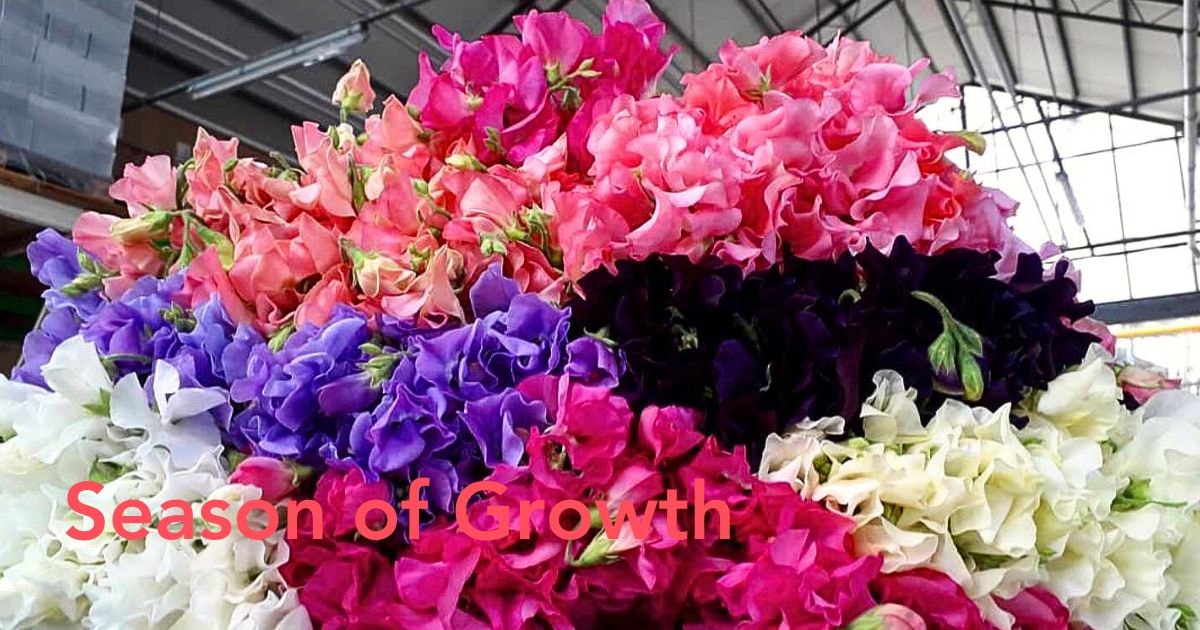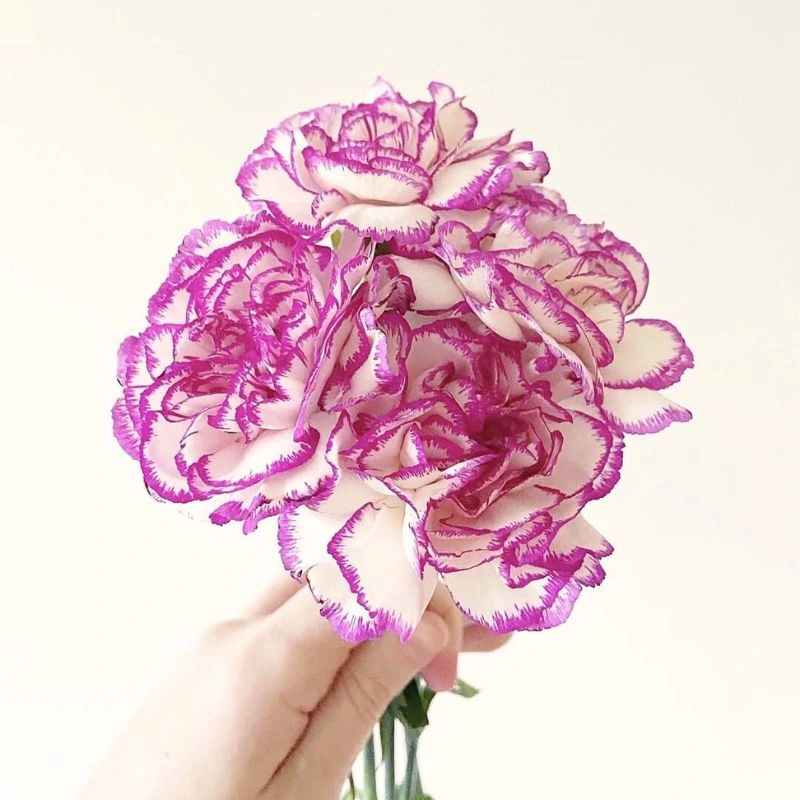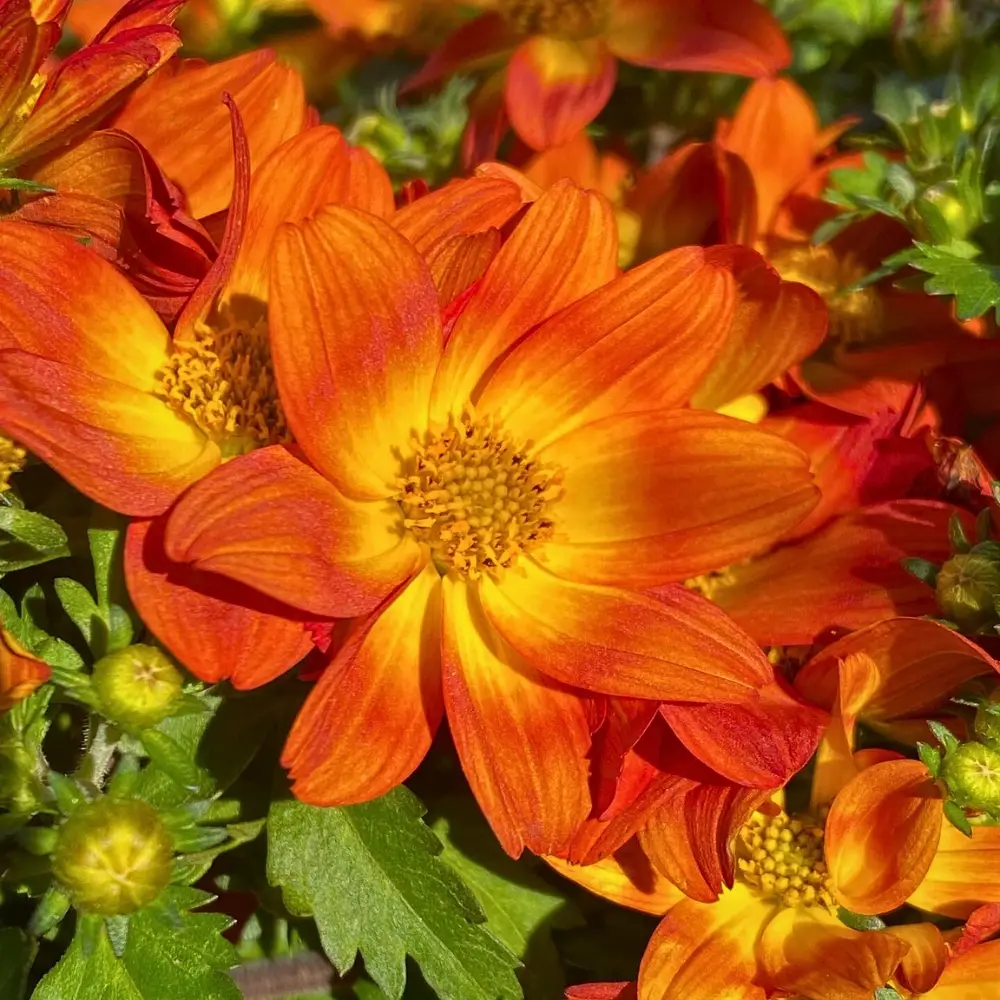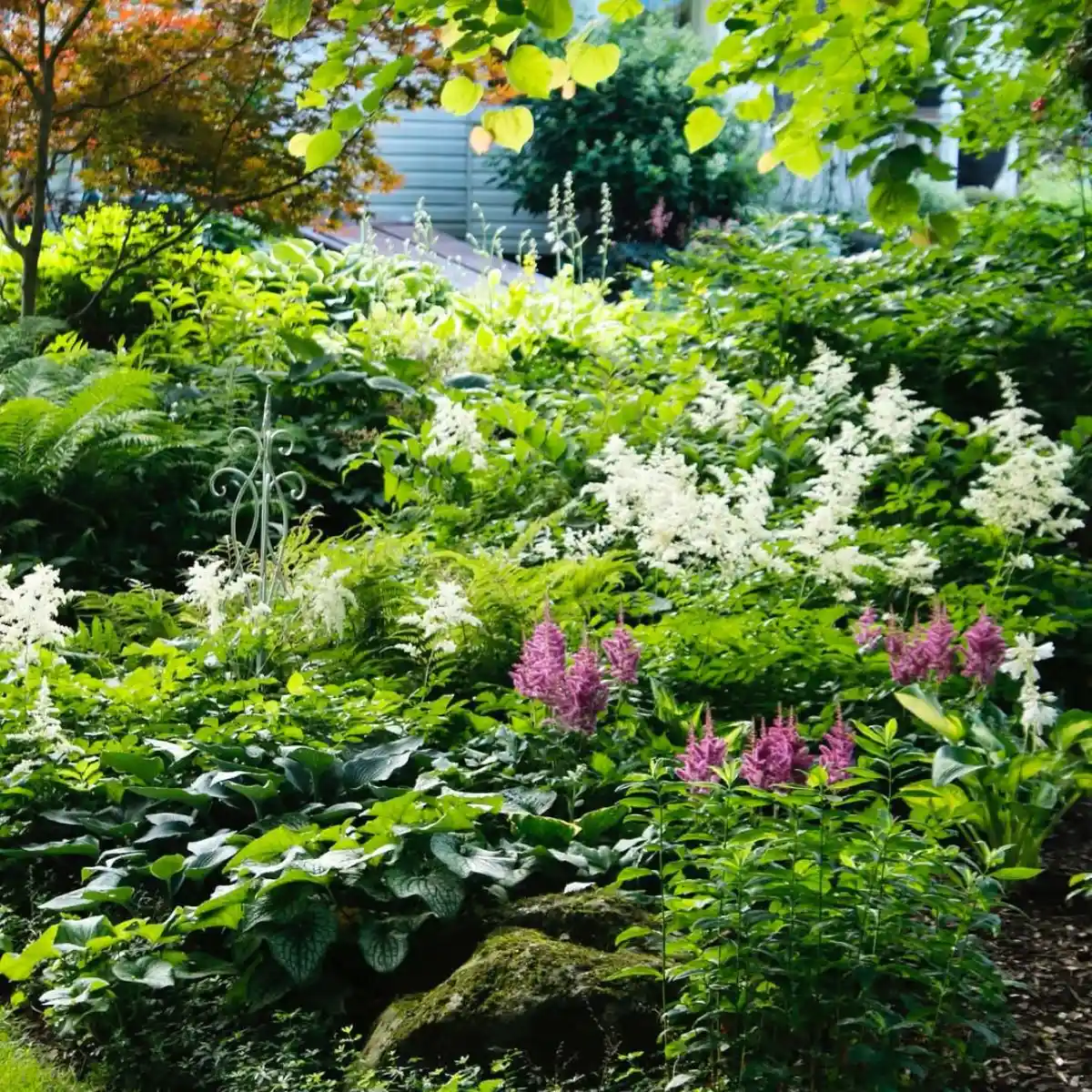April is a special month marked by new beginnings and fresh starts. It is a time when nature signals a season of growth, making it a perfect moment to celebrate the April birth flower. In fact, April is honored by two birth flowers rather than one.
These beautiful flowers—the daisy and the sweet pea—hold symbolic meanings of innocence, purity, gratitude, and blissful pleasure. Whether you’re an April baby seeking to learn more about your birth flower, or simply intrigued by the meaning behind April birthdays, dive into this guide on April’s birth flowers to discover their history, symbolism, and significance.
Unveiling the April Month Birth Flower Duo - Daisy and Sweet Pea
Many months boast a single birth flower, but April proudly presents two flowers that capture the spirit of spring: the daisy (Bellis perennis) and sweet pea (Lathyrus odoratus). Daisies are admired for their white petals, sunny centers, and long history of symbolic meanings across different cultures.
Sweet peas are known for their enchanting scent and delicate appearance, cherished by gardeners for their enchanted fragrance (often described as a sweet fragrance) that offers a gentle sense of joy.

The Historical and Cultural Roots of Daisy and Sweet Pea
Daisies are native to regions across Europe, Africa, and North America. During the Middle Ages, they were sometimes linked to the Virgin Mary, symbolizing purity and devotion. Moreover, ancient Egyptians recognized certain medicinal uses of the daisy for common ailments. Over time, daisy varieties like the English daisy and the well-known Shasta daisies became popular in gardens for their hardy nature.
In contrast, the sweet pea journeyed from southern Italy and Sicily, introduced to England by a Sicilian monk in the 17th century. Gardeners were captivated by the sweet fragrance of these flowers, and their popularity soared. Sweet peas represent farewells, gratitude, and friendship, and they were particularly admired by Victorians for conveying heartfelt emotions through bouquets and arrangements.
The Brightness of April Birth Month Flower #1: Daisy (Bellis Perennis)
The daisy, a symbol of purity and innocence, is one of the two flowers representing April's birth month, casting a brightness that rivals the spring sun itself.
This flower, often depicted in the hands of children and lovers, carries more than just aesthetic appeal; it embodies deep symbolic meanings and a color symbolism that transcends the visual.

Historic Symbolism of the Daisy
The daisy has been cherished for its innocence, true love, and new beginnings. Its name is said to come from the Anglo-Saxon term 'daes eage', meaning 'day’s eye', referencing how it opens to the sun each morning and closes at night. During the Middle Ages, knights wore daisies to show loyalty, and some traditions connected them with fresh starts in life.
Mythologically, the Roman story of Vertumnus, the god of the seasons, and the nymph Belides explains how the nymph transformed herself into the flower Bellis to escape Vertumnus' unwanted attention.
Christians have often linked the daisy to the Virgin Mary and childlike purity, highlighting its status as a symbol of gentleness and sincere affection.
Exploring Daisy's Color Symbolism
The daisy, with its rich symbolism, stands as a multifaceted symbol embodying various emotions. It signifies new beginnings, pure love, and the joy of life. The classic white daisy, with its yellow heart, represents innocence and happiness, while pink daisies show affection, and red ones denote passion. Yellow variants radiate cheerfulness, akin to sunlight, and the rare blue daisy signifies tranquility.
Embracing a wide emotional range, the daisy especially resonates with April-born individuals through its serene yet profound allure.

Fascinating, Historical, and Amusing Facts About Daisy
The daisy's historical voyage reflects its significance across cultures, embodying themes of purity and transformation from ancient remedies to chivalric symbols.
- The Roman Connection: Vertumnus, the god of Seasons, adored Belides, who became a daisy to evade him, linking the flower to themes of metamorphosis and the sun.
- A Cosmic Connection: In Norse mythology, the daisy family showcases remarkable diversity and adaptability.
- A Rich Variety: Boasting over 20,000 species, the daisy family showcases remarkable diversity and adaptability.
- Victorian Language of Flowers: In Victorian symbolism, daisies stood for innocence, purity, and true love, allowing discreet expression of emotions.
- A Tool of Divination: The "He loves me, he loves me not!" game, of French origin, underlines daisy's association with love and destiny.
- The Daisy-Chain Connection: Making daisy chains, a symbol of innocence, was thought to protect children from fairy abductions.
- A Favorite Among Bees: Vital to bees, daisies provide nectar and pollen, benefiting from their composite flowers.
- A Literary Significance: Daisies have inspired literary giants like Geoffrey Chaucer, symbolizing the sun in their works.
- A Medicinal Marvel: Ancient Egyptians valued daisies for their healing properties, particularly in treating eye conditions and other ailments.
- An Artistic Muse: The daisy's simple beauty captivated artists like Claude Monet, who featured it prominently in Impressionist art.
- An Edible Flower: Certain daisy species are edible, adding a spicy flavor to culinary dishes.
- Versatility, Resilience, and Growth: Daisies flourish across diverse climates, signaling spring's arrival with their early blooms.
- Chivalric Emblem: In medieval Europe, knights wore daisies as symbols of fidelity and honor.
- A Calendar Flower: The daisy represents April's birth flower and the fifth wedding anniversary, denoting fidelity and love.
- A Gardener's Friend: Their low maintenance and resilience make daisies a cherished choice among gardeners, thriving in varied conditions.

The Delight of April's Flower of the Month #2: Sweet Pea (Lathyrus Odoratus)
April brings a vibrant tapestry of hues and scents, prominently featuring the sweet pea as a symbol of warmth and delight, swaying with the spring wind.
Esteemed as April's floral emblem, along with the daisy, the sweet pea captivates with its slender tendrils and lively petals, embodying the essence of floral language and botanical elegance.
Let's explore the rich symbolism and color meaning behind the sweet pea, revealing its allure.
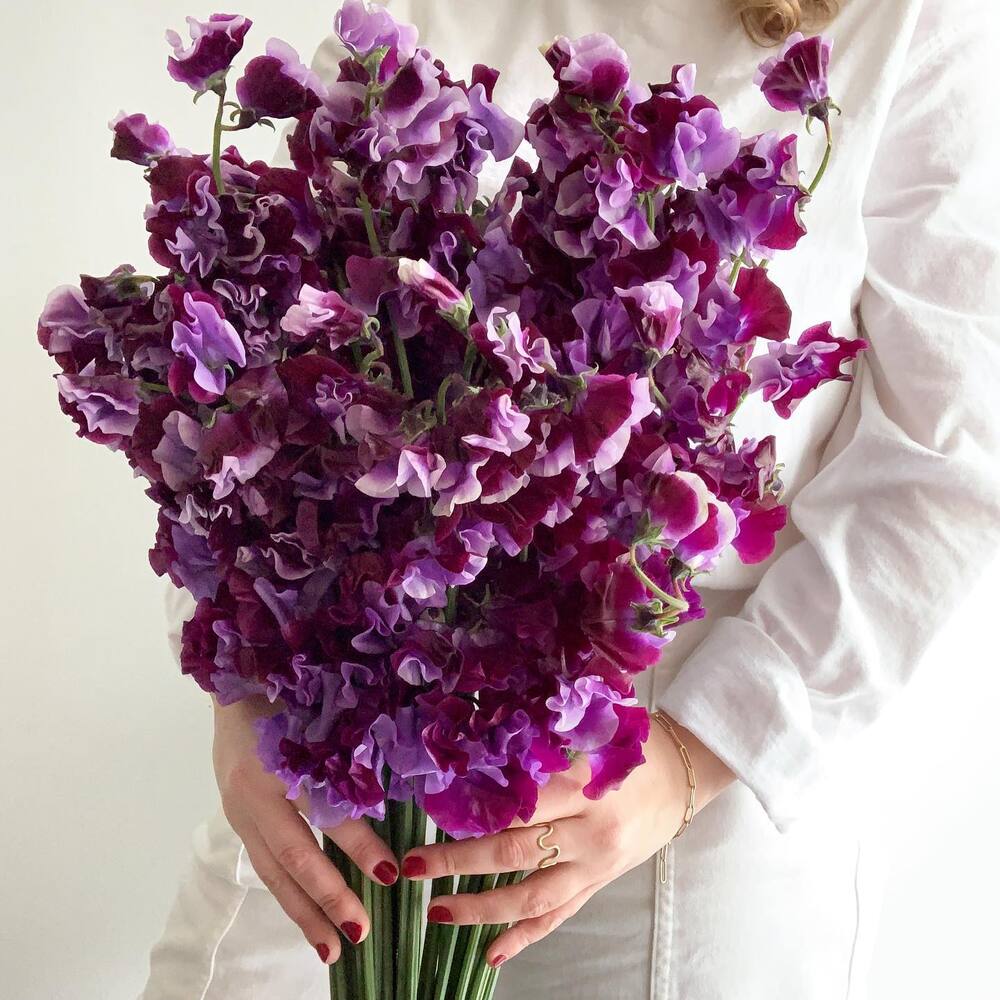
The Deep Symbolism Behind the Sweet Pea
The sweet pea (Lathyrus odoratus) is among April’s birth flowers, often associated with blissful pleasure, partings, and warm wishes. Victorians used sweet peas in bouquets to communicate gratitude or tender farewells. The sweet peas represent a gentle way to say “thank you,” “goodbye,” or “good luck,” all wrapped in a sweet fragrance.
Introduced to the world by a Sicilian monk from southern Italy, sweet peas quickly took root in England, where their enchanting scent became highly sought after. Over centuries, horticultural enthusiasts expanded the color palette, giving us pink, purple, red, cream, and bi-color varieties.
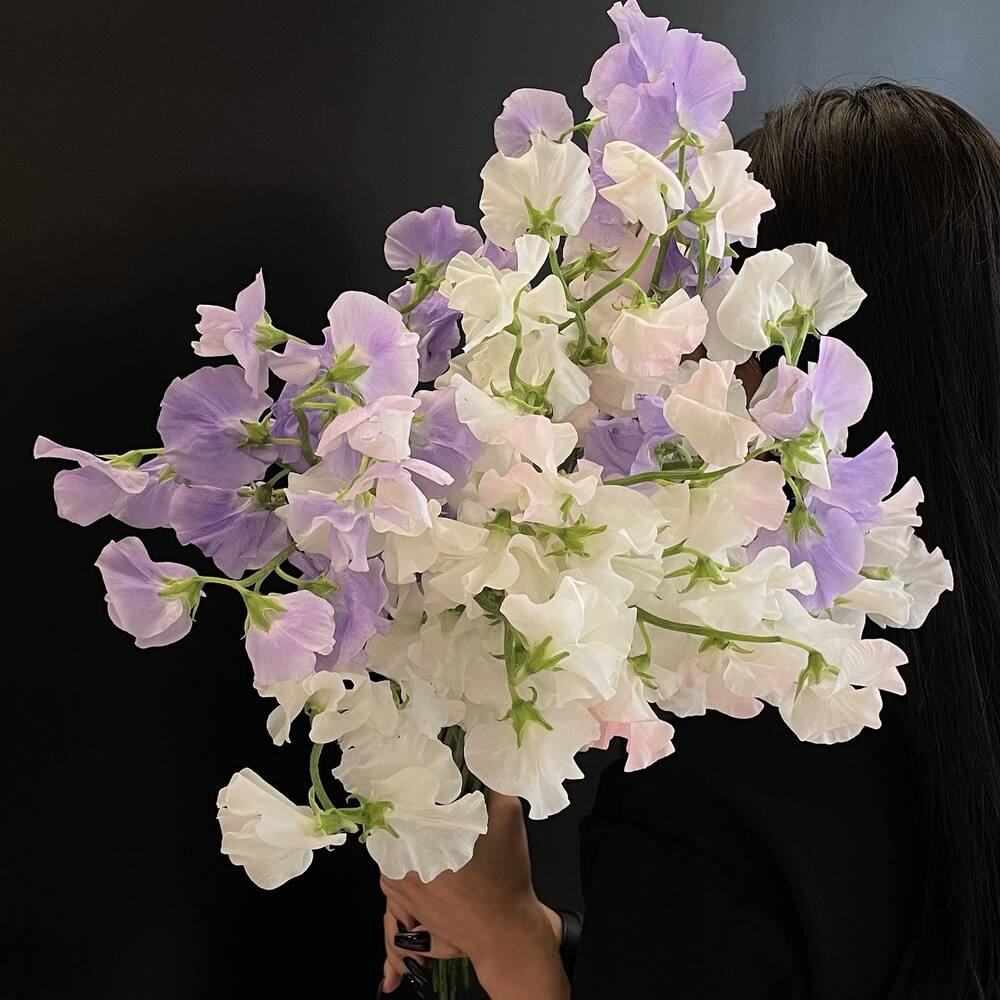
The Color Significance of Sweet Pea
The sweet pea's color spectrum, ranging from muted pastels to vivid tones, encapsulates diverse emotions and sentiments.
Pale pinks symbolize soft affection, while bold reds and purples express gratitude and deep farewells. Whites and creams denote purity and joy, offering a versatile palette for conveying personal messages.
Beyond its aesthetic appeal, the sweet pea serves as a medium for personal expression, enriching our interactions with a blend of historical significance, emotional depth, and aromatic allure.
It embodies April's essence and the vibrancy of spring, highlighting nature's ability to foster profound connections and evoke a rich tapestry of feelings.
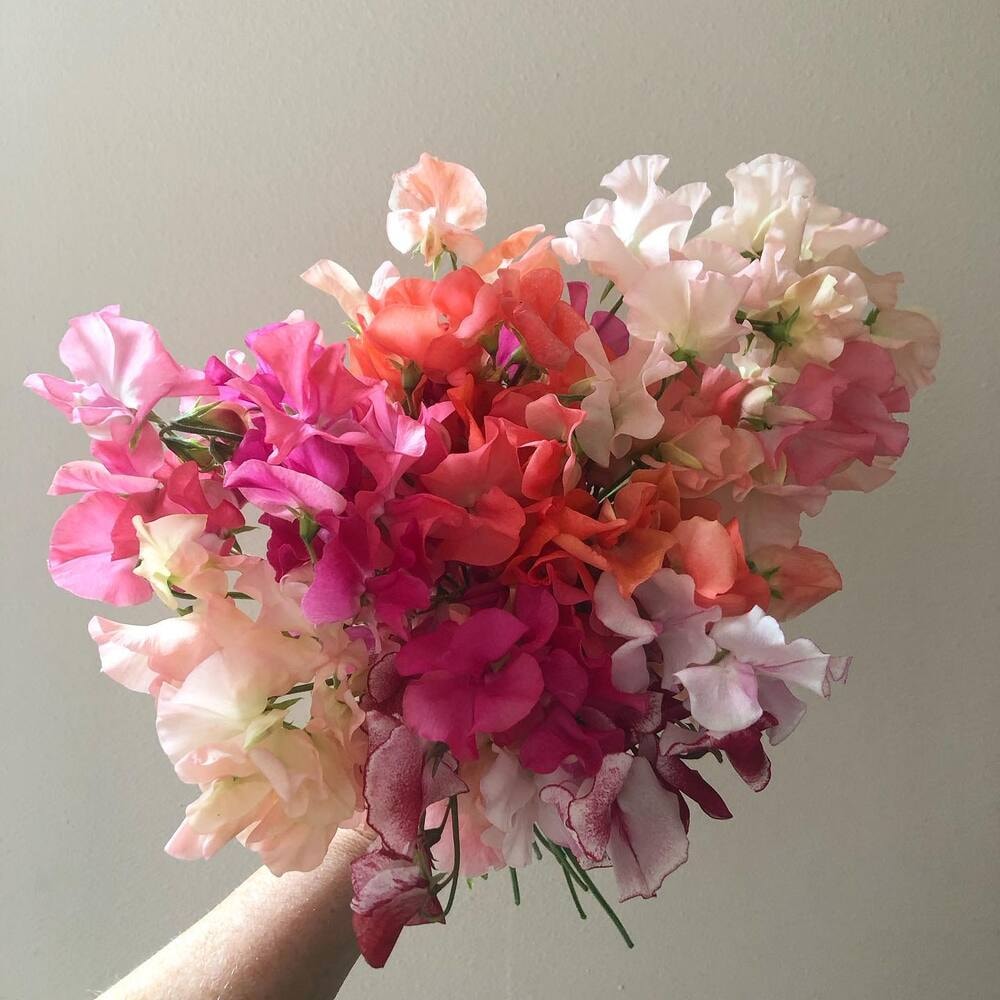
Intriguing, Historical, and Fun Facts About Sweet Pea
As one of April's birth flowers, sweet peas encapsulate the essence of spring with their fragrant blooms and vibrant color. Here are some fascinating facts about the sweet pea that celebrate its charm and legacy:
- A Monk's Gift: Franciscus Cupani, a Sicilian monk, introduced sweet pea (Lathyrus odoratus) to Europe in the 17th century, marking the beginning of its journey as a beloved garden flower.
- Royal Adoration: Sweet pea's enchanting fragrance won the heart of King Edward VII, elevating its status in early 20th-century England.
- Horticultural Innovator: Henry Eckford, known as "The Father of the Sweet Pea," revolutionized the flower through cross-breeding, enhancing both its scent and color palette.
- Color Spectrum Expansion: From its original purple, selective breeding has broadened sweet pea's hues to include pink, white, red, and lavender, though blue and yellow remain elusive.
- Record-Holding Blooms: A sweet pea variety boasting a stem longer than 18 inches holds the world record for stem length, showcasing the flower's impressive potential.
- Genetic Research Pioneer: Gregor Mendel's use of sweet peas in genetic studies laid foundational insights into inheritance and traits.
- Symbol of Resilience: In World War I England, sweet peas symbolized hope and perseverance, contributing to war funds and morale.
- Toxic Beauty: Despite their captivating scent, sweet peas are toxic and not to be consumed, contrasting with edible peas.
- Floral Contest Tradition: The National Sweet Pea Society, established in the early 20th century UK, perpetuates the legacy of sweet peas through annual contests.
- Annual Phenomenon: Sweet peas epitomize the transient beauty of life, completing their life cycle from seed to flower within a single year.
- Pollinator Attraction: Their fragrance serves a dual purpose, pleasing humans and attracting pollinators like bees and butterflies.
- Emotional Symbolism: Sweet peas represent a spectrum of emotions, including pleasure, farewells, and gratitude, making them suitable for various occasions.
- Botanical Debate: The classification of sweet peas as annuals or perennials sparks ongoing discussion among enthusiasts, with perennial varieties existing in milder climates.

The Artistry of April Birth Month Flower Tattoos
The art of tattooing has long served as a canvas for personal expression and storytelling, with the natural world often providing the ink. Among the myriad of designs chosen by those seeking to adorn their skin with a piece of living art, April birth month flower tattoos stand out for their delicate beauty and deep symbolism.
The daisy and sweet pea, April's flowers, offer not just a tribute to the month of one's birth but also an intimate connection to the characteristics they embody.
Celebrating April With Flower Tattoos
The tradition of inking one's skin with the flora of April speaks to a desire to embody the qualities these blooms represent - purity, love, farewell, and bliss. A daisy tattoo with its radiant petals stretching outward mirrors the sun's own rays, embodying innocence, new beginnings, and an indomitable spirit.
In contrast, the sweet pea tattoos whisper tales of tender farewells, heartfelt gratitude, and the joyous anticipation of future reunions. Together, these floral tattoos offer a dual narrative of resilience and renewal, reflecting the multi-faceted human experience with grace.

Personalization and Symbolism of April Birth Month Flower Tattoos
There are many creative avenues to personalize a birth month flower tattoo. English daisies could be inked in full color, highlighting their white petals and yellow centers. Sweet peas might be drawn in pastel pink, blue, or purple. Placement can vary, too: a small daisy on the wrist could serve as a reminder of true love and fresh starts, while a delicate spray of sweet peas near the collarbone might emphasize gratitude and subtle strength.
Incorporating The Beauty of April Flowers Into Your Daily Life
Bringing the charm of the freshness of April's flowers into everyday spaces transforms them, infusing them with life, color, and a sense of renewal that echoes the essence of spring.
The daisy and sweet peas, April's heralds, offer more than just their beauty; they bring layers of meaning and versatility to both home decor and professional settings.
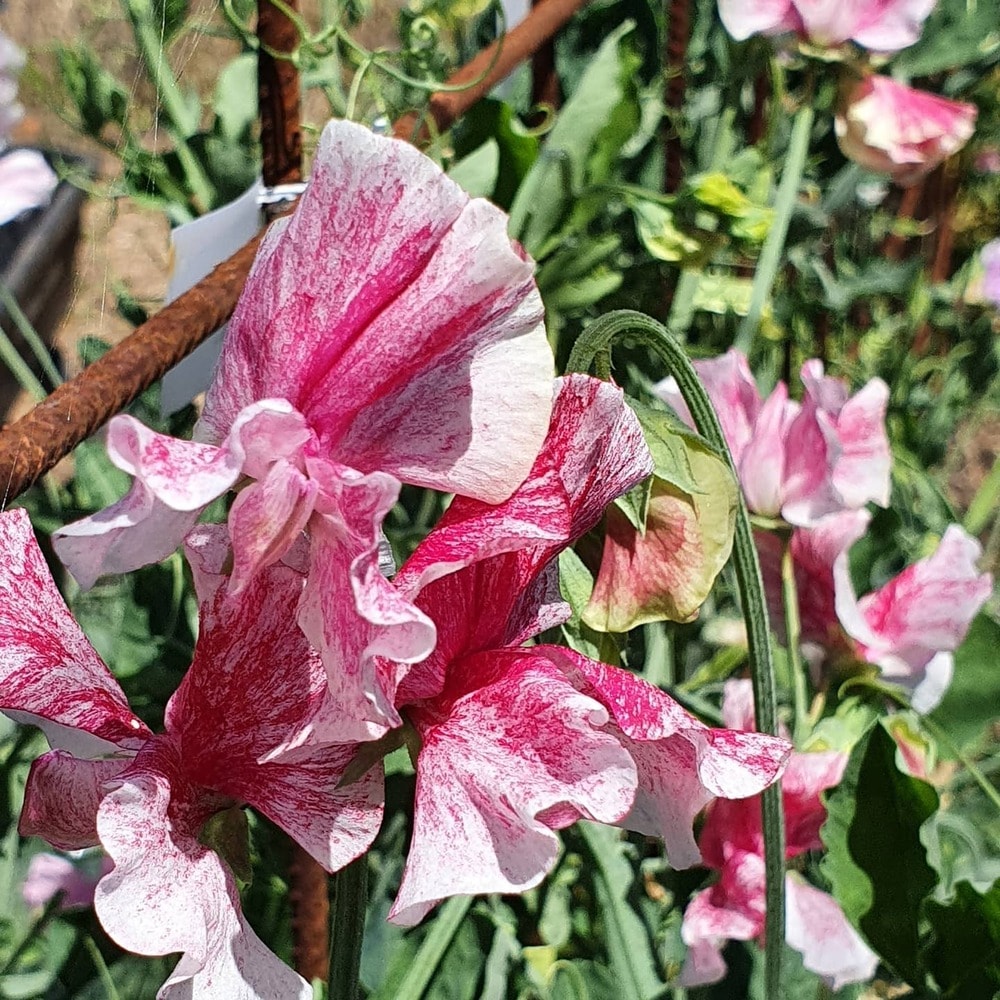
Daisy and Sweet Pea as Home Decor
The simplicity of the daisy and the elegance of the sweet pea can elevate the aesthetic of any living space, creating an ambiance that resonates with the freshness of spring.
- In the Living Room: A bouquet of daisies and sweet peas, placed in a sunlit corner or upon a coffee table, can transform the room's atmosphere, infusing it with lightness and a subtle fragrance. Opt for a mix of colors to create a focal point that's both inviting and reflective of April's diverse palette.
- Bedroom Tranquility: For a touch of serenity, consider delicate sweet pea arrangements by your bedside or daisy-patterned linens. These touches not only beautify the space but also serve as a gentle reminder of the world's natural wonders as you start and end your day.
- Kitchen and Dining: Fresh daisies in a vase on a dining table or a windowsill planter with sweet peas can add a dash of color and vitality to spaces where families gather, blending functionality with natural beauty.
- Terrariums and Indoor Gardens: Incorporating daisies and sweet peas into indoor gardens or terrariums can create a miniature landscape of April's splendor, offering a daily connection to the natural world.
- Pressed Flowers: For a more lasting decoration, pressed daisies and sweet peas can be framed and hung as artwork, bringing a piece of April's beauty into the home in a delicate and understated manner.

Wonders of April Birth Flowers in Professional Settings
Incorporating daisies and sweet peas into professional environments transforms them into sources of inspiration and serenity. These flowers beautify and promote positivity and productivity across various spaces:
- Reception Areas: Daisies and sweet peas in reception convey warmth and hospitality, positively influencing first impressions and reflecting well on the business.
- Workspaces: Placing these flowers on desks or in communal areas mitigates stress and enhances creativity, reminding onlookers of nature's balance and well-being.
- Corporate Events: Their use in events or meetings introduces elegance and thoughtfulness, improving participant experiences.
- Outdoor Areas: Establishing gardens with these and other April blooms offers employees a tranquil retreat for breaks, leading to a healthier work atmosphere.
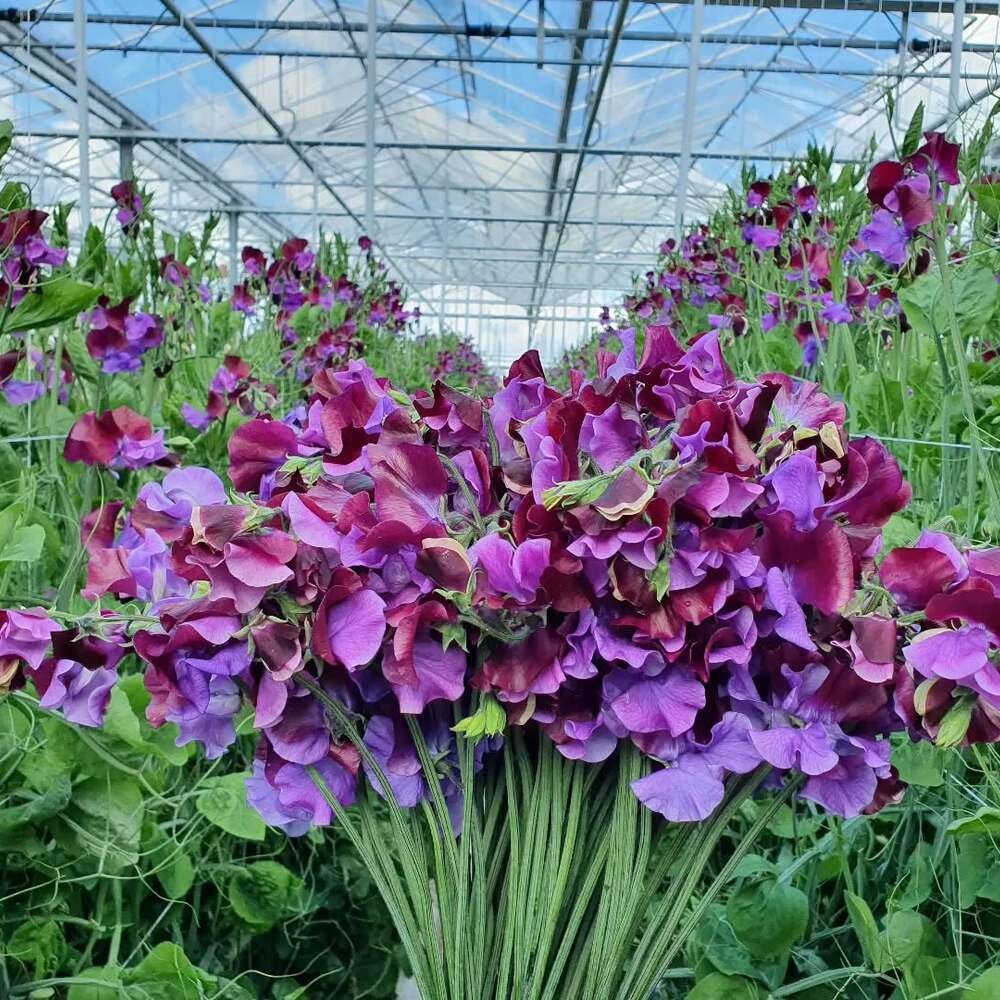
Gardening Tips for Sweet Peas and Daisies
Gardening, a dance with nature's rhythms, brings the joy of nurturing life from the soil. For those enchanted by the allure of April's flowers, here are tips to cultivate sweet peas and daisies, turning your garden into a springtime haven.
- For the Sweet Pea:
- Timing: Begin in late winter or early spring. Start seeds indoors to transplant after frost for best growth in cool conditions.
- Soil: Prefer well-drained, organically rich soil with a pH of 6.0-7.5.
- Sowing: After soaking seeds for 24 hours to soften, plant them 2-3 cm (1 inch) deep and 5 cm (2 inches) apart.
- Support: Provide trellises for these climbers right from the start.
- Watering: Maintain moist soil, using mulch to conserve moisture and cool roots.
- Feeding: Use a low-nitrogen, high-potassium fertilizer for more blooms, avoiding high-nitrogen mixes.
- Sunlight: Full sun is ideal, with partial afternoon shade in hot areas.
- Deadheading: Regularly remove spent blooms to enhance flowering.
- For the Daisy:
- Location: Ensure a minimum of 6 hours of sunlight daily in a well-lit area.
- Soil: Best in well-drained, moderately fertile soil with neutral pH.
- Planting: Directly sow seeds in spring or space establishing plants 15 cm (6 inches) deep and 30 cm (12 inches) apart.
- Watering: Water deeply but infrequently, allowing soil to dry slightly between sessions.
- Mulching: Apply organic mulch to retain moisture, suppress weeds, and cool roots.
- Pruning: Deadhead regularly for a tidy appearance and more blooms. Cut back in late autumn.
- Division: Divide every few years in spring or autumn to prevent overcrowding and rejuvenate.
A Bright Finale: Celebrating Daisy and Sweet Pea
In the spirit of April birth, the daisy and sweet pea each hold a special meaning for anyone born during this month or those who simply treasure beautiful flowers. From ancient times to modern celebrations, these April birth flowers inspire sentiments of innocence, gratitude, and fresh beginnings. Whether showcased in bouquets, cultivated in your garden, or commemorated in a tattoo, the daisy and sweet pea continue to bring joy and reflect the essence of spring. By learning their stories and symbolic meanings, you honor not only the April baby in your life but also the timeless charm these flowers offer to everyone.
Feature image by @gardening_the_good_life, header image by @dentist_priyankasaokarnavale.

